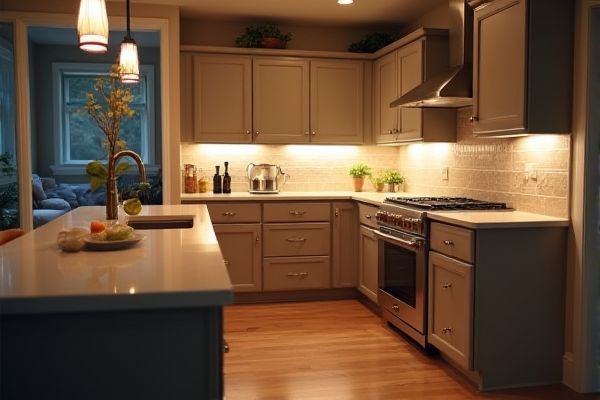
Under-cabinet lighting provides focused illumination on countertops, enhancing task visibility and reducing shadows, while overhead lighting offers broader room coverage but can create glare or insufficient light in specific areas. Explore the advantages and best uses of each option to optimize your kitchen's lighting design.
Table of Comparison
| Feature | Under-Cabinet Lighting | Overhead Lighting |
|---|---|---|
| Purpose | Task-specific illumination for countertops | General room lighting and overall illumination |
| Light Distribution | Focused, localized light on work surfaces | Wide, evenly distributed light across the room |
| Installation | Mounted underneath cabinets, often LED strips or puck lights | Ceiling-mounted fixtures such as recessed lights, chandeliers, or flush mounts |
| Energy Efficiency | Typically uses low-wattage LEDs, energy-efficient | Varies by fixture type; LED overhead lights are energy efficient |
| Aesthetic Impact | Enhances workspace visibility; modern and sleek appearance | Defines room ambiance; can be decorative or minimalistic |
| Cost | Generally lower cost and easier to install | Can be higher cost depending on fixture and installation complexity |
| Maintenance | Easy access for bulb replacement and cleaning | May require ladders or professional help for maintenance |
| Common Applications | Kitchen countertops, workbenches, display shelves | Living rooms, bedrooms, kitchens, office spaces |
Introduction to Under-Cabinet and Overhead Lighting
Under-cabinet lighting enhances task visibility by illuminating countertops directly, reducing shadows and improving workspace efficiency in kitchens and offices. Overhead lighting provides broad, ambient illumination, ensuring overall room brightness and complementing focused lighting sources. Your choice depends on functionality and aesthetic needs, balancing focused light with general coverage for optimal lighting design.
Key Differences Between Under-Cabinet and Overhead Lighting
Under-cabinet lighting offers focused task illumination directly onto countertops, enhancing visibility for cooking and food preparation, while overhead lighting provides broad, ambient light that covers the entire kitchen space. Under-cabinet fixtures are typically low-profile LED strips or puck lights that reduce shadows and glare, in contrast to overhead lights like ceiling-mounted chandeliers or recessed fixtures which may create uneven lighting. The energy efficiency and targeted illumination of under-cabinet lighting improve kitchen functionality, whereas overhead lighting supports general visibility and overall room aesthetics.
Pros and Cons of Under-Cabinet Lighting
Under-cabinet lighting offers focused illumination directly onto countertops, enhancing visibility for tasks like cooking and food preparation while reducing shadows cast by overhead lights. It is energy-efficient, often using LED strips, and adds aesthetic value by highlighting backsplashes and cabinetry details but may require professional installation for wiring and can be less effective for general room lighting. You benefit from improved workspace clarity with under-cabinet lighting but might need to supplement with overhead lighting to ensure comprehensive room illumination.
Pros and Cons of Overhead Lighting
Overhead lighting provides broad illumination, making it ideal for general room visibility and tasks requiring wide coverage. However, it can create shadows and glare, especially in workspaces like kitchens, reducing visibility and causing eye strain. Your lighting setup may benefit from combining overhead lights with task-specific options such as under-cabinet lighting to optimize both brightness and precision.
Energy Efficiency Comparison: Under-Cabinet vs. Overhead
Under-cabinet lighting consumes significantly less energy than traditional overhead lighting due to targeted illumination, reducing the need for high-wattage bulbs in entire rooms. LED under-cabinet fixtures typically use 4-10 watts compared to 60-100 watts for standard overhead bulbs, offering enhanced energy savings and lower electricity bills. You can improve your home's energy efficiency by choosing under-cabinet lighting for task-specific areas while relying on overhead lighting only when necessary.
Installation and Maintenance Considerations
Under-cabinet lighting offers a streamlined installation, often requiring minimal wiring and easy mounting beneath cabinets, which suits DIY enthusiasts and reduces overall setup time. Overhead lighting typically involves more complex installation, including ceiling wiring and possible fixture support, necessitating professional assistance to ensure safety and compliance with electrical codes. Maintenance for under-cabinet lighting is simpler due to accessible placement for bulb replacement and cleaning, while overhead lighting fixtures may be harder to reach, increasing upkeep difficulty and time.
Design and Aesthetic Impact
Under-cabinet lighting enhances kitchen aesthetics by providing focused illumination that highlights countertops and backsplashes, creating a layered lighting effect and adding depth to the space. Overhead lighting offers broad, ambient light essential for general visibility but may cause shadows on work surfaces, affecting visual clarity. Incorporating under-cabinet lights complements overhead fixtures by combining functional task lighting with refined design, elevating the overall ambiance and sophistication of kitchen interiors.
Best Applications for Each Lighting Type
Under-cabinet lighting is ideal for task-oriented spaces such as kitchen countertops, workbenches, and reading nooks, providing focused illumination that reduces shadows and enhances visibility. Overhead lighting is best suited for general room illumination, ensuring even light distribution in living rooms, dining areas, and hallways. Combining both lighting types creates a balanced ambiance, offering both functional task lighting and overall spatial brightness.
Cost Analysis and Budget Considerations
Under-cabinet lighting typically costs less to install and consume less energy, making it a budget-friendly option for enhancing workspace illumination. Overhead lighting involves higher installation costs due to wiring and fixtures, but offers broader room coverage, potentially reducing the need for multiple light sources. Your choice should balance initial expenses with long-term energy savings and desired lighting functionality.
How to Choose the Right Lighting for Your Space
Choosing the right lighting for your space depends on the function and ambiance you desire; under-cabinet lighting offers focused illumination ideal for task areas like kitchen counters, whereas overhead lighting provides general brightness suitable for overall room visibility. Consider the size of your room, natural light availability, and the activities performed to select lighting that enhances functionality and aesthetics. Your choice impacts energy efficiency and comfort, so evaluate LED options for long-lasting, adjustable, and dimmable features.
 homyna.com
homyna.com